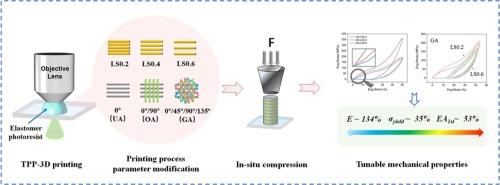通过控制打印路径的稀疏度和螺旋度来调节双光子聚合弹性体的刚度
IF 6.8
1区 工程技术
Q1 ENGINEERING, MANUFACTURING
引用次数: 0
摘要
双光子聚合(TPP)是制造高精度微纳三维结构的新兴技术之一。TPP中使用的常见树脂材料仅限于丙烯酸酯或环氧低聚物。这些树脂的机械性能在暴露后难以调整,限制了它们在生物医学、软机器人和微电子等先进领域的应用。本文设计了一种基于聚氨酯丙烯酸酯(PUA)的弹性体光刻胶,它结合了聚氨酯的柔韧性和丙烯酸酯的快速固化特性。利用TPP-3D打印技术制备了具有良好自支撑性能的微结构,并通过控制线间距和旋转角度来调节弹性体光刻胶的力学性能。通过现场压缩试验,发现弹性体光刻胶的模量可从284 MPa调整到665 MPa,屈服强度可从43 MPa调整到59 MPa,初始循环吸能可从18 MJ/m3调整到27 MJ/m3,显示了通过打印参数调整力学性能的有效策略。最后,设计并打印了三种类型的可回收结构,验证了这种弹性体光刻胶在柔性电子和微电子设备保护中的应用潜力。该研究为弹性体光刻胶的设计和TPP-3D打印结构的力学性能可调提供了有效的方法。本文章由计算机程序翻译,如有差异,请以英文原文为准。

Tuning the stiffness of two-photon polymerized elastomer by controlling the sparsity and helicity of printing paths
Two-photon polymerization (TPP) is one of the emerging technologies for manufacturing high-precision micro-nano 3D structures. Common resin materials used in TPP are limited to, for example, acrylates or epoxy oligomers. The mechanical properties of these resins are difficult to tune after exposure, limiting their applications in advanced fields such as biomedicine, soft robotics, and microelectronics. In this work, an elastomer photoresist based on polyurethane acrylate (PUA) is designed, which combines the flexibility of polyurethane with the rapid curing characteristics of acrylates. Microstructures with good self-supporting properties are prepared by TPP-3D printing, and the mechanical properties of the elastomer photoresist are tuned by controlling the line spacing and rotation angle. Through in-situ compression tests, it is found that the modulus of the elastomer photoresist could be tuned from 284 MPa to 665 MPa, the yield strength from 43 MPa to 59 MPa, and the initial cycle energy absorption from 18 MJ/m3 to 27 MJ/m3, showcasing an effective strategy of tuning mechanical properties through printing parameters. Finally, three types of recoverable structures are designed and printed, validating the potential of this elastomer photoresist for applications in flexible electronics and microelectronic device protection. This study provides an effective approach for the design of elastomer photoresist and the tunable mechanical properties of TPP-3D printed structure.
求助全文
通过发布文献求助,成功后即可免费获取论文全文。
去求助
来源期刊

Journal of Manufacturing Processes
ENGINEERING, MANUFACTURING-
CiteScore
10.20
自引率
11.30%
发文量
833
审稿时长
50 days
期刊介绍:
The aim of the Journal of Manufacturing Processes (JMP) is to exchange current and future directions of manufacturing processes research, development and implementation, and to publish archival scholarly literature with a view to advancing state-of-the-art manufacturing processes and encouraging innovation for developing new and efficient processes. The journal will also publish from other research communities for rapid communication of innovative new concepts. Special-topic issues on emerging technologies and invited papers will also be published.
 求助内容:
求助内容: 应助结果提醒方式:
应助结果提醒方式:


